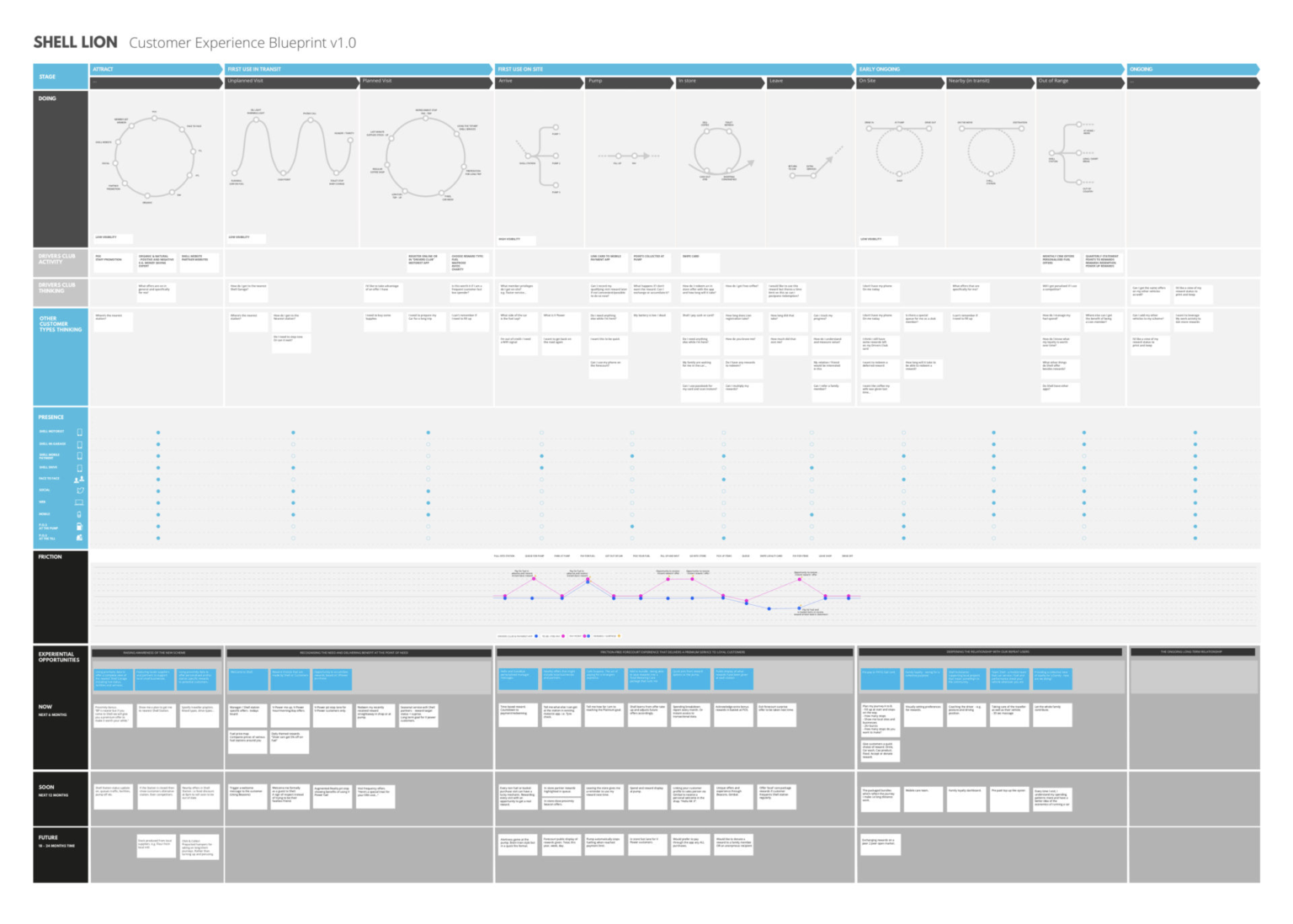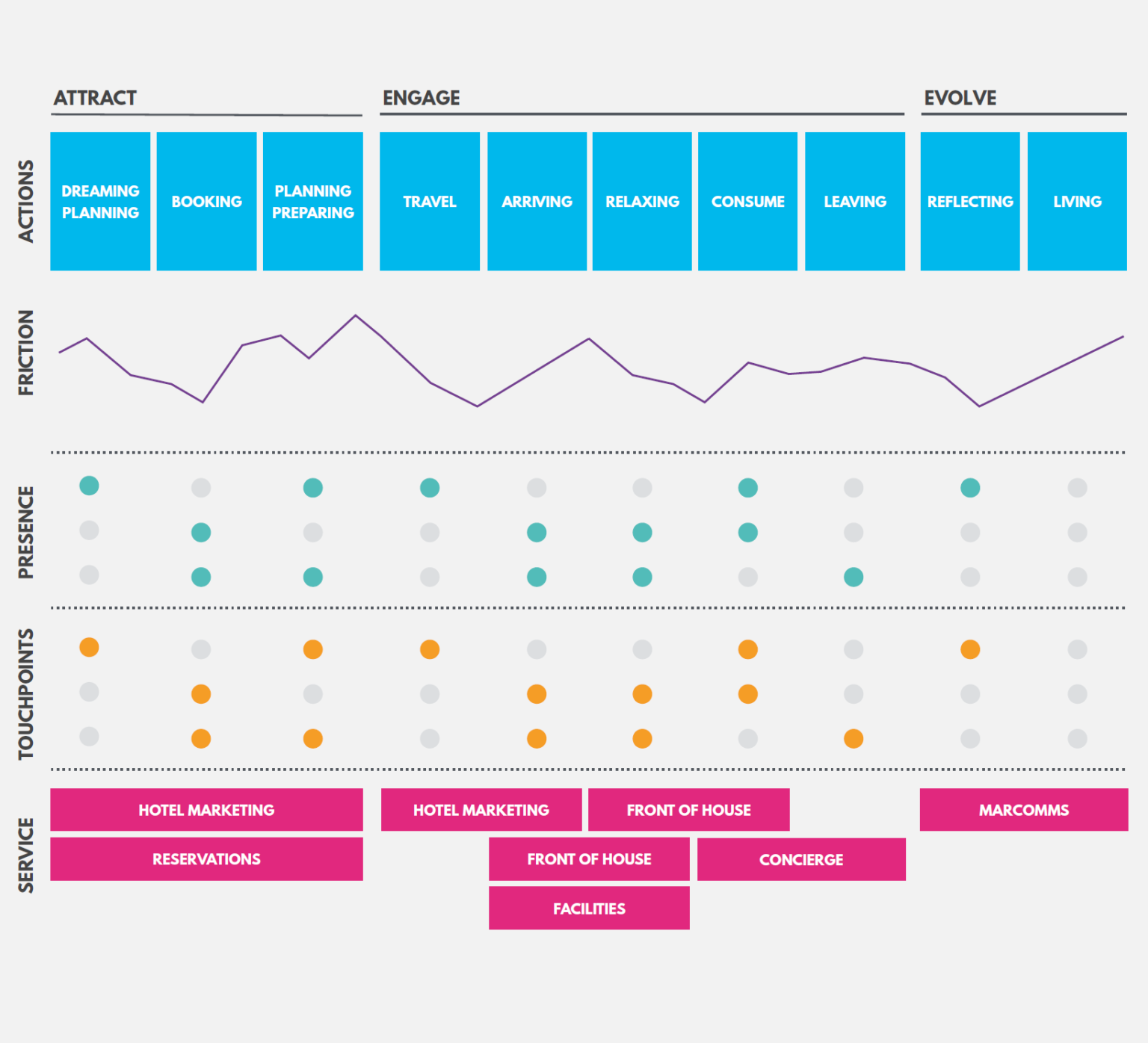Some of our most successful conversations with key clients have been around our Experience Blueprint. Because until everyone is aligned, it’s very hard for new product and service innovation to be realised in full. So, what is the Blueprint?
Based on a customer journey map, with additional rigour, it displays every interaction with a brand or service. The detail gets more forensic as layer-by-layer we uncover the systems, processes and teams that provide the end-to-end service to your customer. The Blueprint has evolved through the 10 years we’ve been helping clients identify new service opportunities, and has become a cornerstone of our work.
Alignment requires a sensitive balancing act, often throwing an honest focus on the strengths and weaknesses within a company. The power of the Blueprint is to relieve tension in the customer experience through open and collaborative ideation. The Blueprint uncovers and plays back a view of the business that they have never seen before: interconnected systems and business verticals laid out in a schematic, all anchored to the customer experience.
Typically, businesses are arranged vertically around departments, but the Blueprint works horizontally across these departments. It allows us to see in one place the channels, departments, actions and actors that are in-play at any point in time — as well as the data that links them together.
To create the Experience Blueprint, we leverage knowledge and build a complete view across the organisation. One of the most powerful moments in the creation of a new service is when we bring people together to collaborate, share and tap into each other’s insights in order to create the first draft of the Blueprint — aligning them around a single view of their business.
Once we understand how the overall CX looks today, we can start to ideate around the new service opportunities that either improve the current experience low-points. Or find new ways of creating value at key points of the overall experience. These might be blind spots today, or prove to be a way of evolving our relationship with the customer beyond what we currently offer.

The Experience Blueprint helped us identify opportunity areas for Shell’s loyalty programme
Collaborators come to Blueprint creation sessions with myriad points of view on the same challenge. So, it’s important to frame these sessions in a way that brings out the best from each perspective — exploring barriers as well as opportunities. It’s crucial to get a good cross-section of stakeholders together at the start. That way, we can continue to solicit their feedback as we move through the stages of creation.
What ELSE delivers for our clients is a powerful, highly collaborative tool that helps them bring concepts and ideas to relevant stakeholders in an accessible way — to discuss, vet, prioritise and then implement. Collectively teams gain insight into a wider context for their own role within the company and, ultimately, how that benefits their customers.
The concepts of frontstage and backstage — those parts of the service that will be visible or invisible to the customer — are core to the Blueprint. Deciding how much to show your customers, and how much to keep backstage, defines and nurtures a sense of magic and delight for your service experience. Often, it’s possible to enhance the value these services generate for customers by having them appear, as if by magic, right when they’re needed. While customers don’t need to see the hard work and systems that make these moments of magic possible, stakeholders absolutely do.
The Blueprint also helps to highlight where you have dormant capabilities that could be better leveraged. For example, how customer data can be used to enhance and personalise the experience at different points.
By highlighting all the ownable moments for your brand, we present a powerful case for alignment around the service we want to create together.
The Experience Blueprint will look at your customer’s journey across three key stages — Attract, Engage, Evolve.

Within the business, each unit will have different priorities and some of them might be competing. This tool allows the business to see levels of engagement with the brand or service and the business responsible for it.
As we develop the Blueprint, it’s important to define the desired emotional takeaways we’re trying to create. So, we might offer a moment in the experience that is already functionally correct, but if dealt with in the right way would be elevated to become an ownable moment for that brand experience. These moments can be discussed and vetted in the context of the overall journey, with stakeholders and design teams making joint decisions on where we should be delivering key moments.
This is either perspective led or fed through sentiment data. We use an ‘emotional arc’ to chart the high, low and neutral points in the experience with a view to identifying any opportunities that may arise.
With the data we gather, we’re able to define an Experience Blueprint to help identify future opportunities and sets the brief for the next 18+ months. Your whole team, regardless of discipline, will be able see the role they play. And all stakeholders will have clear sight of where the proposition is strong and, more importantly, where it is weak. So then they can be aligned on what to do next to build a first-class customer experience.
ELSE have delivered transformative experiences for key clients such as Shell, Ibis, UBS and O2. Get in touch to find out more about how we can help your organisation to align with the best way forward.